+ Open data
Open data
- Basic information
Basic information
| Entry | Database: EMDB / ID: EMD-30853 | |||||||||
|---|---|---|---|---|---|---|---|---|---|---|
| Title | Human Calcium-Sensing Receptor bound with calcium ions | |||||||||
 Map data Map data | ||||||||||
 Sample Sample |
| |||||||||
 Keywords Keywords | GPCR / class C / calcium sensing receptor / MEMBRANE PROTEIN | |||||||||
| Function / homology |  Function and homology information Function and homology informationbile acid secretion / regulation of presynaptic membrane potential / chemosensory behavior / response to fibroblast growth factor / cellular response to peptide / cellular response to vitamin D / phosphatidylinositol-4,5-bisphosphate phospholipase C activity / Class C/3 (Metabotropic glutamate/pheromone receptors) / calcium ion import / positive regulation of positive chemotaxis ...bile acid secretion / regulation of presynaptic membrane potential / chemosensory behavior / response to fibroblast growth factor / cellular response to peptide / cellular response to vitamin D / phosphatidylinositol-4,5-bisphosphate phospholipase C activity / Class C/3 (Metabotropic glutamate/pheromone receptors) / calcium ion import / positive regulation of positive chemotaxis / fat pad development / cellular response to hepatocyte growth factor stimulus / amino acid binding / branching morphogenesis of an epithelial tube / positive regulation of calcium ion import / regulation of calcium ion transport / cellular response to low-density lipoprotein particle stimulus / anatomical structure morphogenesis / detection of calcium ion / JNK cascade / positive regulation of vasoconstriction / axon terminus / chloride transmembrane transport / ossification / response to ischemia / cellular response to glucose stimulus / adenylate cyclase-inhibiting G protein-coupled receptor signaling pathway / G protein-coupled receptor activity / positive regulation of insulin secretion / intracellular calcium ion homeostasis / vasodilation / integrin binding / presynaptic membrane / phospholipase C-activating G protein-coupled receptor signaling pathway / G alpha (i) signalling events / cellular response to hypoxia / basolateral plasma membrane / G alpha (q) signalling events / transmembrane transporter binding / positive regulation of ERK1 and ERK2 cascade / apical plasma membrane / G protein-coupled receptor signaling pathway / neuronal cell body / positive regulation of cell population proliferation / calcium ion binding / positive regulation of gene expression / protein kinase binding / glutamatergic synapse / cell surface / protein homodimerization activity / identical protein binding / plasma membrane Similarity search - Function | |||||||||
| Biological species |  Homo sapiens (human) Homo sapiens (human) | |||||||||
| Method | single particle reconstruction / cryo EM / Resolution: 3.8 Å | |||||||||
 Authors Authors | Ling SL / Tian CL | |||||||||
| Funding support |  China, 1 items China, 1 items
| |||||||||
 Citation Citation |  Journal: Cell Res / Year: 2021 Journal: Cell Res / Year: 2021Title: Structural mechanism of cooperative activation of the human calcium-sensing receptor by Ca ions and L-tryptophan. Authors: Shenglong Ling / Pan Shi / Sanling Liu / Xianyu Meng / Yingxin Zhou / Wenjing Sun / Shenghai Chang / Xing Zhang / Longhua Zhang / Chaowei Shi / Demeng Sun / Lei Liu / Changlin Tian /  Abstract: The human calcium-sensing receptor (CaSR) is a class C G protein-coupled receptor (GPCR) responsible for maintaining Ca homeostasis in the blood. The general consensus is that extracellular Ca is ...The human calcium-sensing receptor (CaSR) is a class C G protein-coupled receptor (GPCR) responsible for maintaining Ca homeostasis in the blood. The general consensus is that extracellular Ca is the principal agonist of CaSR. Aliphatic and aromatic L-amino acids, such as L-Phe and L-Trp, increase the sensitivity of CaSR towards Ca and are considered allosteric activators. Crystal structures of the extracellular domain (ECD) of CaSR dimer have demonstrated Ca and L-Trp binding sites and conformational changes of the ECD upon Ca/L-Trp binding. However, it remains to be understood at the structural level how Ca/L-Trp binding to the ECD leads to conformational changes in transmembrane domains (TMDs) and consequent CaSR activation. Here, we determined the structures of full-length human CaSR in the inactive state, Ca- or L-Trp-bound states, and Ca/L-Trp-bound active state using single-particle cryo-electron microscopy. Structural studies demonstrate that L-Trp binding induces the closure of the Venus flytrap (VFT) domain of CaSR, bringing the receptor into an intermediate active state. Ca binding relays the conformational changes from the VFT domains to the TMDs, consequently inducing close contact between the two TMDs of dimeric CaSR, activating the receptor. Importantly, our structural and functional studies reveal that Ca ions and L-Trp activate CaSR cooperatively. Amino acids are not able to activate CaSR alone, but can promote the receptor activation in the presence of Ca. Our data provide complementary insights into the activation of class C GPCRs and may aid in the development of novel drugs targeting CaSR. | |||||||||
| History |
|
- Structure visualization
Structure visualization
| Movie |
 Movie viewer Movie viewer |
|---|---|
| Structure viewer | EM map:  SurfView SurfView Molmil Molmil Jmol/JSmol Jmol/JSmol |
| Supplemental images |
- Downloads & links
Downloads & links
-EMDB archive
| Map data |  emd_30853.map.gz emd_30853.map.gz | 9.9 MB |  EMDB map data format EMDB map data format | |
|---|---|---|---|---|
| Header (meta data) |  emd-30853-v30.xml emd-30853-v30.xml emd-30853.xml emd-30853.xml | 10.8 KB 10.8 KB | Display Display |  EMDB header EMDB header |
| Images |  emd_30853.png emd_30853.png | 135.6 KB | ||
| Filedesc metadata |  emd-30853.cif.gz emd-30853.cif.gz | 5.8 KB | ||
| Archive directory |  http://ftp.pdbj.org/pub/emdb/structures/EMD-30853 http://ftp.pdbj.org/pub/emdb/structures/EMD-30853 ftp://ftp.pdbj.org/pub/emdb/structures/EMD-30853 ftp://ftp.pdbj.org/pub/emdb/structures/EMD-30853 | HTTPS FTP |
-Validation report
| Summary document |  emd_30853_validation.pdf.gz emd_30853_validation.pdf.gz | 357.4 KB | Display |  EMDB validaton report EMDB validaton report |
|---|---|---|---|---|
| Full document |  emd_30853_full_validation.pdf.gz emd_30853_full_validation.pdf.gz | 357 KB | Display | |
| Data in XML |  emd_30853_validation.xml.gz emd_30853_validation.xml.gz | 6.6 KB | Display | |
| Data in CIF |  emd_30853_validation.cif.gz emd_30853_validation.cif.gz | 7.5 KB | Display | |
| Arichive directory |  https://ftp.pdbj.org/pub/emdb/validation_reports/EMD-30853 https://ftp.pdbj.org/pub/emdb/validation_reports/EMD-30853 ftp://ftp.pdbj.org/pub/emdb/validation_reports/EMD-30853 ftp://ftp.pdbj.org/pub/emdb/validation_reports/EMD-30853 | HTTPS FTP |
-Related structure data
| Related structure data | 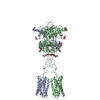 7dttMC  7dtuC  7dtvC  7dtwC M: atomic model generated by this map C: citing same article ( |
|---|---|
| Similar structure data |
- Links
Links
| EMDB pages |  EMDB (EBI/PDBe) / EMDB (EBI/PDBe) /  EMDataResource EMDataResource |
|---|---|
| Related items in Molecule of the Month |
- Map
Map
| File |  Download / File: emd_30853.map.gz / Format: CCP4 / Size: 125 MB / Type: IMAGE STORED AS FLOATING POINT NUMBER (4 BYTES) Download / File: emd_30853.map.gz / Format: CCP4 / Size: 125 MB / Type: IMAGE STORED AS FLOATING POINT NUMBER (4 BYTES) | ||||||||||||||||||||||||||||||||||||||||||||||||||||||||||||||||||||
|---|---|---|---|---|---|---|---|---|---|---|---|---|---|---|---|---|---|---|---|---|---|---|---|---|---|---|---|---|---|---|---|---|---|---|---|---|---|---|---|---|---|---|---|---|---|---|---|---|---|---|---|---|---|---|---|---|---|---|---|---|---|---|---|---|---|---|---|---|---|
| Projections & slices | Image control
Images are generated by Spider. | ||||||||||||||||||||||||||||||||||||||||||||||||||||||||||||||||||||
| Voxel size | X=Y=Z: 1.014 Å | ||||||||||||||||||||||||||||||||||||||||||||||||||||||||||||||||||||
| Density |
| ||||||||||||||||||||||||||||||||||||||||||||||||||||||||||||||||||||
| Symmetry | Space group: 1 | ||||||||||||||||||||||||||||||||||||||||||||||||||||||||||||||||||||
| Details | EMDB XML:
CCP4 map header:
| ||||||||||||||||||||||||||||||||||||||||||||||||||||||||||||||||||||
-Supplemental data
- Sample components
Sample components
-Entire : Full-lenth Human Calcium-Sensing Receptor bound with 20 mM calciu...
| Entire | Name: Full-lenth Human Calcium-Sensing Receptor bound with 20 mM calcium ions |
|---|---|
| Components |
|
-Supramolecule #1: Full-lenth Human Calcium-Sensing Receptor bound with 20 mM calciu...
| Supramolecule | Name: Full-lenth Human Calcium-Sensing Receptor bound with 20 mM calcium ions type: complex / ID: 1 / Parent: 0 / Macromolecule list: #1 |
|---|---|
| Source (natural) | Organism:  Homo sapiens (human) Homo sapiens (human) |
-Macromolecule #1: Extracellular calcium-sensing receptor
| Macromolecule | Name: Extracellular calcium-sensing receptor / type: protein_or_peptide / ID: 1 / Number of copies: 2 / Enantiomer: LEVO |
|---|---|
| Source (natural) | Organism:  Homo sapiens (human) Homo sapiens (human) |
| Molecular weight | Theoretical: 123.520828 KDa |
| Recombinant expression | Organism:  |
| Sequence | String: MKTIIALSYI FCLVFADYKD DDDENLYFQG YGPDQRAQKK GDIILGGLFP IHFGVAAKDQ DLKSRPESVE CIRYNFRGFR WLQAMIFAI EEINSSPALL PNLTLGYRIF DTCNTVSKAL EATLSFVAQN KIDSLNLDEF CNCSEHIPST IAVVGATGSG V STAVANLL ...String: MKTIIALSYI FCLVFADYKD DDDENLYFQG YGPDQRAQKK GDIILGGLFP IHFGVAAKDQ DLKSRPESVE CIRYNFRGFR WLQAMIFAI EEINSSPALL PNLTLGYRIF DTCNTVSKAL EATLSFVAQN KIDSLNLDEF CNCSEHIPST IAVVGATGSG V STAVANLL GLFYIPQVSY ASSSRLLSNK NQFKSFLRTI PNDEHQATAM ADIIEYFRWN WVGTIAADDD YGRPGIEKFR EE AEERDIC IDFSELISQY SDEEEIQHVV EVIQNSTAKV IVVFSSGPDL EPLIKEIVRR NITGKIWLAS EAWASSSLIA MPQ YFHVVG GTIGFALKAG QIPGFREFLK KVHPRKSVHN GFAKEFWEET FNCHLQEGAK GPLPVDTFLR GHEESGDRFS NSST AFRPL CTGDENISSV ETPYIDYTHL RISYNVYLAV YSIAHALQDI YTCLPGRGLF TNGSCADIKK VEAWQVLKHL RHLNF TNNM GEQVTFDECG DLVGNYSIIN WHLSPEDGSI VFKEVGYYNV YAKKGERLFI NEEKILWSGF SREVPFSNCS RDCLAG TRK GIIEGEPTCC FECVECPDGE YSDETDASAC NKCPDDFWSN ENHTSCIAKE IEFLSWTEPF GIALTLFAVL GIFLTAF VL GVFIKFRNTP IVKATNRELS YLLLFSLLCC FSSSLFFIGE PQDWTCRLRQ PAFGISFVLC ISCILVKTNR VLLVFEAK I PTSFHRKWWG LNLQFLLVFL CTFMQIVICV IWLYTAPPSS YRNQELEDEI IFITCHEGSL MALGFLIGYT CLLAAICFF FAFKSRKLPE NFNEAKFITF SMLIFFIVWI SFIPAYASTY GKFVSAVEVI AILAASFGLL ACIFFNKIYI ILFKPSRNTI EEVRCSTAA HAFKVAARAT LRRSNVSRKR SSSLGGSTGS TPSSSISSKS NSEDPFPQPE RQKQQQPLAL TQQEQQQQPL T LPQQQRSQ QQPRCKQKVI FGSGTVTFSL SFDEPQKNAM AHRNSTHQNS LEAQKSSDTL TRHEPLLPLQ CGETDLDLTV QE TGLQGPV GGDQRPEVED PEELSPALVV SSSQSFVISG GGSTVTENVV NSHHHHHHHH HH UniProtKB: Extracellular calcium-sensing receptor |
-Macromolecule #4: CALCIUM ION
| Macromolecule | Name: CALCIUM ION / type: ligand / ID: 4 / Number of copies: 4 / Formula: CA |
|---|---|
| Molecular weight | Theoretical: 40.078 Da |
-Macromolecule #5: 2-acetamido-2-deoxy-beta-D-glucopyranose
| Macromolecule | Name: 2-acetamido-2-deoxy-beta-D-glucopyranose / type: ligand / ID: 5 / Number of copies: 8 / Formula: NAG |
|---|---|
| Molecular weight | Theoretical: 221.208 Da |
| Chemical component information | 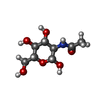 ChemComp-NAG: |
-Experimental details
-Structure determination
| Method | cryo EM |
|---|---|
 Processing Processing | single particle reconstruction |
| Aggregation state | particle |
- Sample preparation
Sample preparation
| Buffer | pH: 7.5 |
|---|---|
| Vitrification | Cryogen name: ETHANE |
- Electron microscopy
Electron microscopy
| Microscope | FEI TITAN KRIOS |
|---|---|
| Image recording | Film or detector model: GATAN K2 SUMMIT (4k x 4k) / Detector mode: COUNTING / Average electron dose: 62.0 e/Å2 |
| Electron beam | Acceleration voltage: 300 kV / Electron source:  FIELD EMISSION GUN FIELD EMISSION GUN |
| Electron optics | Illumination mode: SPOT SCAN / Imaging mode: DIFFRACTION |
| Experimental equipment |  Model: Titan Krios / Image courtesy: FEI Company |
- Image processing
Image processing
| Startup model | Type of model: NONE |
|---|---|
| Final reconstruction | Resolution.type: BY AUTHOR / Resolution: 3.8 Å / Resolution method: FSC 0.143 CUT-OFF / Number images used: 315050 |
| Initial angle assignment | Type: MAXIMUM LIKELIHOOD |
| Final angle assignment | Type: MAXIMUM LIKELIHOOD |
 Movie
Movie Controller
Controller




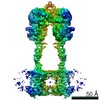




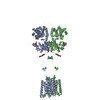




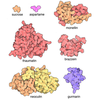
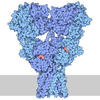
 Z (Sec.)
Z (Sec.) Y (Row.)
Y (Row.) X (Col.)
X (Col.)





















